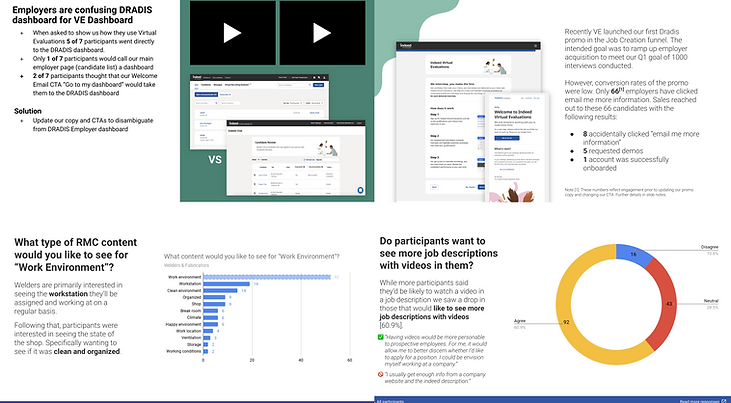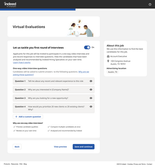
Incubator
In Incubator I worked with multiple cross-functional teams where I led the end-to-end design process as the sole UX strategic partner in a fast paced environment. Our teams focused on building and testing new products and features for Indeed from 0 to 1 and beyond. Below you can see and overview of my process highlighting the when, why, and how of each step.


Gather
-
When: A new initiative, project, or idea is proposed
-
Why: It is important to understand how users are currently solving the problem or working around it.
-
How: To quickly gather information, it can be helpful to talk to users, experts in the field, and colleagues who have knowledge of the area. Other methods include pulling from existing research, running surveys, or examining competitors or related concepts.

Clarify
-
When: Before investing resources in a new initiative.
-
Why: It's crucial to evaluate if it's worth pursuing by understanding the space and user needs, and clarifying goals and potential advantages.
-
How: For larger projects, it's important to have a conversation with stakeholders to solidify goals. Smaller projects may skip this evaluation process.


Ideate
-
When: Once the team is confident in a problem to solve
-
Why: the ideation phase is crucial to gather feedback and ideas from various stakeholders and experts to ensure buy-in and a shared sense of direction.
-
How: Achieved through a sprint-style kick-off or brainstorming session with individuals who will be involved in the project, as well as subject matter experts and stakeholders. The session starts with a review of available information, followed by clarification of the problem, and finally ideation on unique solutions.

Design
-
When: After the ideation session.
-
Why: Once the plan has been established, the designer can jump into action to define and validate the details.
-
How: This can be done through testing a clickable prototype with various methods such as 1:1 interviews with potential users, hallway feedback, unmoderated testing services like usertesting.com, or critique sessions with other designers.

Handoff
-
When: After designs are ready and engineering is ready to start implementing into production.
-
Why: A smooth handoff can help reduce coding delays and mitigate design debt.
-
How: In the handoff between UX designers and engineers, I prioritize collaboration. With organized design files, clear practices, and detailed ticket notes, I ensure seamless transitions and foster open communication to quickly solve blockers and keep the project moving.


Measure
-
When: Once engineering has built and launched a solution
-
Why: 99% of projects are not one-and-done. As part of the product development cycle you continue to measure and improve features as new data comes to light.
-
How: This is an ongoing cycle in the standard product development process. User research is conducted to understand where the team hit the mark and where they missed. This process helps identify problems and unanswered questions that can be addressed to improve the product.
Work samples
A collection of hi-fi mocks from various projects. If you're team is interested in seeing more in-depth case studies I'm happy to share my work during a portfolio review.







